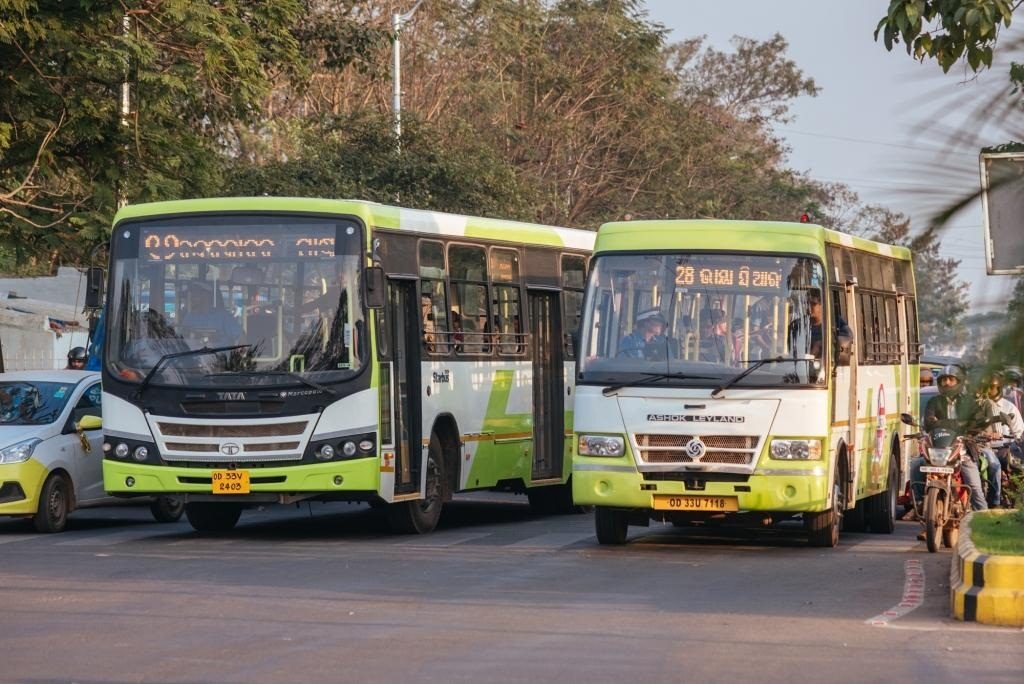Susanta Mishra
Bhubaneswar, the capital of Odisha, is an emerging urban centre, and it finds its name among the world’s top-20 global smart city ranking. Its nearby city, Cuttack often known as the sister city of Bhubaneswar, was the British time capital. Cultural legacy of Cuttack vis-à-vis the smart emerging urban culture in Bhubaneswar often complement each other and together they are branded as twin cities of Odisha. Amidst all the positive talk, people often find it difficult to travel smoothly between these two cities. Lack of public mobility intertwined with crowded private buses make travelling experience even worse.
Traffic congestion has a huge negative externality; it reduces productivity of commuters by eating up their time and increases noise and air pollution. Much of the traffic congestion arises from the fact that individuals often use private vehicles for their work. Travellers of the twin cities also use private auto rickshaws and busses for intercity movement. Besides they often face the wrath of price monopoly being fixed by auto and bus associations – rates are exorbitantly high and the travel is not safe. Accidents, thefts, roadside robbery and even rape were reported in the past.
Realising the problem of transportation, in 2018, Chief Minister Naveen Patnaik launched a new city bus service, titled “Mo Bus” meaning “my bus” and with extraordinary enthusiasm he took a ride from the airport to his secretariat. His effort is indeed reflected as a great policy towards “moving people, not vehicles”. The cheap and safe travel was expected to undercut the monopoly price of private operators. The government has made this deliberate effort to reduce congestion in the twin cities. From purely economic prospective, public transport has huge positive externality. Now daily commuters find “Mo Bus” service as a safe and cheap alternative and expect that it will break the monopoly of private taxi and bus associations. “Mo Bus” service is available in every half an hour following a strict timetable. The service is hygienic, comfortable with air-conditioning and music facility. The buses are also equipped with CCTV camera, Wi-Fi, online ticketing systems, GPS and a smartphone application. Automated fare collection system through the smart Odyssey City Card make travel more convenient and commuters can plan their journey and book seats in advance using a mobile app.
In the past too, the government had taken several such good steps in the public utility area, yet the take up rate among the public was not encouraging. Therefore, this service should not become inefficient like others. It provides a case for the government to think as to how to make “Mo Bus” service more user-friendly and use insights from behavioural economics to nudge people to use public transport more often.
Thaler and Sunstein in their famous book “Nudge” explain that a nudge “is any aspect of the choice architecture that alters people’s behavior in a predictable way without forbidding any options or significantly changing their economic incentives.” In simple words nudge is a non-intrusive intervention that directly acts on choice architecture to guide people towards a desirable action. Governments’ intervention using nudge in public transport is not uncommon.
The Chicago Transit Authority (CTA) using a real-time bus information system, “CTA Bus Tracker” positively nudged people to increase CTA bus ridership. Similarly, off-peak discount experiment in Hong Kong has resulted into less crowding of Hong Kong’s Mass Transit Railway (Halvorsen et. al, 2016).
Frequent travellers are often influenced by status quo bias; they don’t easily change the mode of transportation and tend to stick to the default local taxi service. To change such tendency the Odisha government may make the “Mo Bus” service a default option for government employees. It can provide monthly travel passes instead of providing transport allowance to employees. In order ensure smooth revenue collection, use of smart Odyssey Card should be made the default mode of payment.
Commuters often maximise their utility through mental calculations, using three key choices, namely, shortest route, cheapest facility and quality of service. They often fail to make the best choice due to limited cognitive ability. In psychology, attention is often viewed as a scarce resource. If you are new to town, or in a vacation to a new city or it is raining, then processing all the travel information for optimal decision is not possible. To overcome this cognitive barrier among twin city travellers, the government must use “salient information” as a nudge tool to motivate people for getting into “Mo Bus”. Railway stations, bus terminals, airport and prominent crowded places in the twin cities of Cuttack and Bhubaneswar should use electronic display, mentioning walk time to nearest “Mo Bus” point. This will drive people to consider public bus service before stepping into a taxi or calling an auto rickshaw.
Another important issue that affects people’s choice for using public transport against their own private vehicle is the “sunk cost bias”. It affects the mid-frequency user category who have already invested money on own vehicle. They often feel that they are “wasting” own resources by choosing public transport. What is on hand is more valuable than what would be acquired in future. This tendency is often referred to as “loss aversion”. The Government of Odisha may encourage such people to use “Mo Bus” service by providing “try-before-you-buy” facility. The pre-paid smart Odyssey Card may have advance credit facility up to 20 per cent of travel cost, which can be used by a traveller during payment.
Apart from the above behavioural economics tools, the government may also use pure economic tools like providing free travel facility to school children and senior citizens for making “Mo Bus” service a best transport option in the twin cities of Odisha.
The author is an IRS officer working with the Ministry of Finance, Government of India and a Li Ka Shing Scholar from the National University of Singapore. Views are personal.
